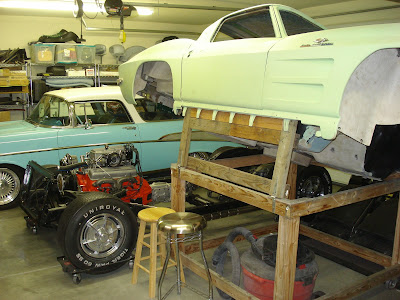In the last 2 weeks we've had -8 degree weather and 8 inches of snow. Neither of these are conducive to painting. None the less that's just what we did, we painted the passenger side wheel wells. Since we couldn't go outside it was necessary to build a make shift paint booth to control over spray. Plastic was wrapped around each wheel well and a plastic flap was positioned over the wheel well opening.
The shop vac was used to collect the over spray.
A fan was used to blow the fumes outside.
It worked great. No over spray, the house didn't smell, and nothing blew up. The matt finish POR 15 paint looks real nice.
The front wheel well looks just as good.
We also installed the shift linkage. 1963 was the only year that had the 1-2 gear linkage cross over the 3-4 gear linkage as shown. All other years the linkage ran parallel to each other.
Ty replaced the last rusty body mount. This one is located inside the engine compartment, on the firewall, on the drivers side. This one drew blood just like the other one.
Ty swapped out the previously installed generic front stabilizer brackets and bushings for these GM manufactured brackets and bushings. These are exactly what would have been installed on a 63 Z06. The stabilizer bar is 7/8" in diameter.
I am not sure what we will work on next. I'd like to complete the drivers side wheel wells but that requires sand blasting and that has to be done outside. I don't have snow tires on the body dolly so the snow has to melt first and that may happen later in the week.
Thanks for watching.




















































